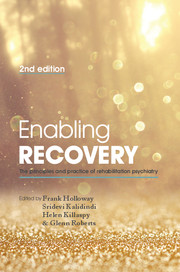Book contents
- Frontmatter
- Contents
- List of contributors
- List of figures, tables and boxes
- Preface
- Part 1 Setting the scene
- Part 2 Treatment approaches
- 7 Treatment approaches: overview
- 8 Rehabilitation at the coalface: practical approaches to helping people improve their functional skills
- 9 Cognitive approaches: cognitive–behavioural therapy and cognitive remediation therapy
- 10 Family interventions
- 11 Working with challenging behaviour
- 12 Working with coexisting substance misuse
- 13 Creative therapies and creativity
- 14 Management of medication when treatment is failing
- 15 Physical healthcare
- Part 3 Key elements of a rehabilitation service
- Part 4 Special topics in psychiatric rehabilitation
- Part 5 Future directions
- Index
13 - Creative therapies and creativity
from Part 2 - Treatment approaches
Published online by Cambridge University Press: 02 January 2018
- Frontmatter
- Contents
- List of contributors
- List of figures, tables and boxes
- Preface
- Part 1 Setting the scene
- Part 2 Treatment approaches
- 7 Treatment approaches: overview
- 8 Rehabilitation at the coalface: practical approaches to helping people improve their functional skills
- 9 Cognitive approaches: cognitive–behavioural therapy and cognitive remediation therapy
- 10 Family interventions
- 11 Working with challenging behaviour
- 12 Working with coexisting substance misuse
- 13 Creative therapies and creativity
- 14 Management of medication when treatment is failing
- 15 Physical healthcare
- Part 3 Key elements of a rehabilitation service
- Part 4 Special topics in psychiatric rehabilitation
- Part 5 Future directions
- Index
Summary
Introduction
Creative therapies, also referred to under umbrella terms such as art therapies or non-verbal therapies, have over many years been discreetly introduced into the portfolio of psychological therapies in many mental health services in the UK. This is despite the fact that it is only relatively recently that an evidence base has been developed, to the extent that the National Institute for Health and Care Excellence (NICE, 2009: pp. 251–257) recommended arts therapies as the only effective treatment of negative symptoms in schizophrenia.
There are a number of reasons why creative therapies have always been attractive to both service users and healthcare providers. Most importantly, these therapies offer a very different way of expressing thoughts and feelings and new ways of communicating with each other. They can help service users who otherwise struggle to engage with or respond to treatment and who have profound difficulty verbalising their feelings, thoughts and life experiences. This is particularly relevant for those service users who have severe, complex and often enduring mental disorders. Creative therapies foster the development of empathy and social interaction, thereby introducing hard-to-engage patients to psychological work in a less direct way.
Rehabilitation psychiatrists have always aimed to work in a holistic way, incorporating the biopsychosocial model. Living well is the aim, not necessarily a complete cure, which for people with longer-term, severe mental illness may not always be achievable. ‘The recovery model’ has further shifted the focus to subjective quality of life and individual psychosocial functioning. While this carries the risk of accepting a degree of ongoing pathology too easily, there are some features at the core of the recovery model that seem more unambiguous: self-empowerment and a clinical strategy that aims to nurture individual skills and capabilities.
Warner (2010) addressed the question of the scientific evidence supporting the recovery model. He emphasised an important additional aspect: ‘The conclusion we may draw from this body of research is that the empowerment of people with mental illness and helping them reduce their internalised sense of stigma are as important as helping them find insight into their illnesses’. Creative therapies lend themselves strongly to this set of objectives, as they require individuals to view things in new ways or from a different perspective, including generating new possibilities or alternatives.
- Type
- Chapter
- Information
- Enabling Recovery , pp. 208 - 223Publisher: Royal College of PsychiatristsPrint publication year: 2015



